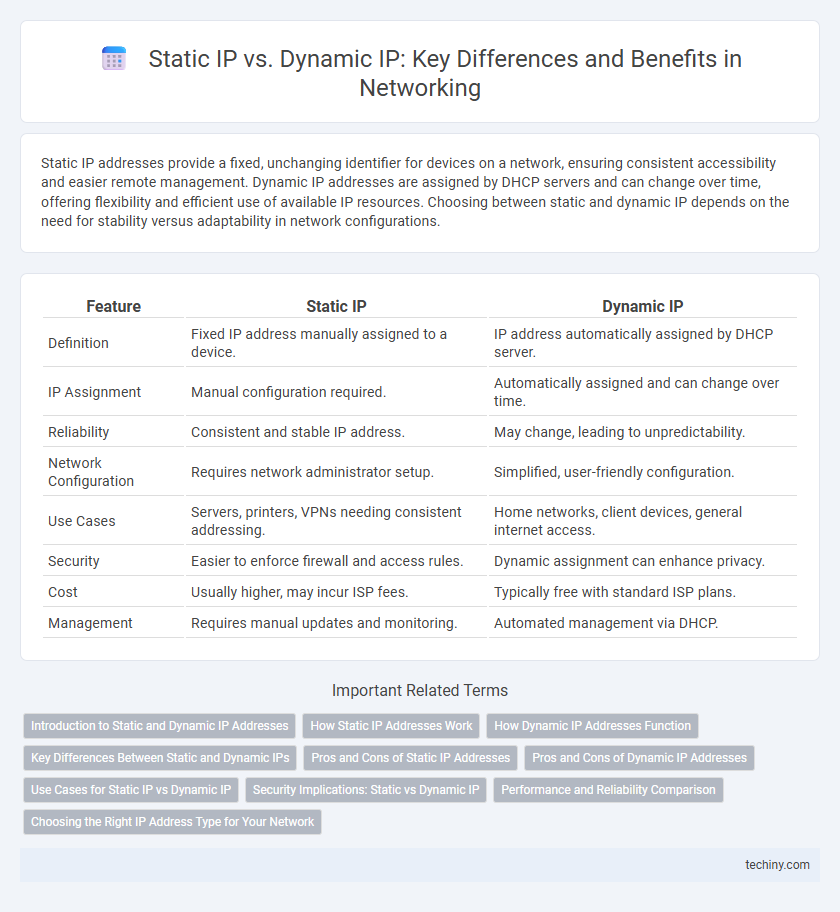Static IP addresses provide a fixed, unchanging identifier for devices on a network, ensuring consistent accessibility and easier remote management. Dynamic IP addresses are assigned by DHCP servers and can change over time, offering flexibility and efficient use of available IP resources. Choosing between static and dynamic IP depends on the need for stability versus adaptability in network configurations.
Table of Comparison
| Feature | Static IP | Dynamic IP |
|---|---|---|
| Definition | Fixed IP address manually assigned to a device. | IP address automatically assigned by DHCP server. |
| IP Assignment | Manual configuration required. | Automatically assigned and can change over time. |
| Reliability | Consistent and stable IP address. | May change, leading to unpredictability. |
| Network Configuration | Requires network administrator setup. | Simplified, user-friendly configuration. |
| Use Cases | Servers, printers, VPNs needing consistent addressing. | Home networks, client devices, general internet access. |
| Security | Easier to enforce firewall and access rules. | Dynamic assignment can enhance privacy. |
| Cost | Usually higher, may incur ISP fees. | Typically free with standard ISP plans. |
| Management | Requires manual updates and monitoring. | Automated management via DHCP. |
Introduction to Static and Dynamic IP Addresses
Static IP addresses provide a fixed, unchanging numerical label assigned to a device on a network, ensuring consistent identification for services like web hosting, remote access, and network management. Dynamic IP addresses are allocated by a DHCP server from a pool of available addresses, allowing flexible and efficient use of IP resources, commonly used in residential and mobile networks. Understanding the differences between static and dynamic IP addressing is essential for network configuration, security protocols, and optimizing connectivity performance.
How Static IP Addresses Work
Static IP addresses function by assigning a fixed numerical label to a device within a network, ensuring consistent identification for communication and resource access. These addresses are manually configured by network administrators or through the DHCP server settings, remaining constant over time. This permanence facilitates reliable remote access, hosting servers, and network management, as devices with static IPs can be easily located and contacted.
How Dynamic IP Addresses Function
Dynamic IP addresses function by assigning temporary, automatically allocated IP numbers to devices through a DHCP server. This system allows efficient reuse of IP addresses, enabling multiple devices to share limited address pools without manual configuration. Dynamic IPs also facilitate seamless network scalability and easier management in environments with frequently changing devices.
Key Differences Between Static and Dynamic IPs
Static IP addresses provide a fixed, unchanging numerical label assigned to a device, ensuring consistent access for hosting servers or running network applications that require stable connections. Dynamic IP addresses are temporarily assigned by DHCP servers, offering flexibility and efficient address allocation but can change periodically, which may disrupt continuous remote access. Key differences include stability and permanence for static IPs versus the adaptability and cost-effectiveness of dynamic IPs in large-scale or residential networks.
Pros and Cons of Static IP Addresses
Static IP addresses offer consistent network identification that is essential for hosting servers, enabling remote access, and ensuring reliable communication between devices. However, they require manual configuration, increasing administrative overhead and potential for misconfiguration. Security risks can arise from their permanence, making static IPs more vulnerable to targeted attacks compared to dynamic IPs.
Pros and Cons of Dynamic IP Addresses
Dynamic IP addresses offer flexibility by automatically assigning available addresses, simplifying network management and reducing manual configuration errors. They enhance security through frequent changes that mitigate risks of targeted attacks but can complicate remote access and cause disruptions for hosting services. Dynamic IPs are cost-effective for most users, though their variability may pose challenges for applications requiring consistent identification.
Use Cases for Static IP vs Dynamic IP
Static IP addresses are ideal for hosting servers, remote access, and running applications that require consistent and reliable connections, such as VPNs, email servers, and websites. Dynamic IP addresses are commonly used for everyday internet activities, including browsing, online gaming, and streaming, where frequent IP changes do not impact performance. Businesses often assign static IPs to network devices needing stable addresses while using dynamic IPs for client devices to simplify network management and conserve IP resources.
Security Implications: Static vs Dynamic IP
Static IP addresses provide consistent network identification, increasing vulnerability to targeted cyberattacks due to their fixed nature. Dynamic IP addresses frequently change, enhancing security by making it harder for attackers to track and exploit the device. Network administrators often prefer dynamic IPs to reduce risk exposure while maintaining flexibility in managing security protocols.
Performance and Reliability Comparison
Static IP addresses offer consistent network performance and high reliability by providing a fixed, unchanging address that facilitates stable connections and easier remote access. Dynamic IP addresses can lead to occasional performance fluctuations due to periodic address changes and DHCP server dependencies, potentially causing temporary connectivity disruptions. For applications requiring uninterrupted access and minimal latency, static IPs generally outperform dynamic IPs in maintaining consistent network stability.
Choosing the Right IP Address Type for Your Network
Choosing the right IP address type for your network depends on factors like device roles and management complexity. Static IPs provide consistent addresses critical for servers, printers, and remote access, ensuring reliability and easier troubleshooting. Dynamic IPs, assigned via DHCP, offer flexibility and efficient address allocation for client devices, reducing administrative overhead in large or changing networks.
Static IP vs Dynamic IP Infographic

 techiny.com
techiny.com